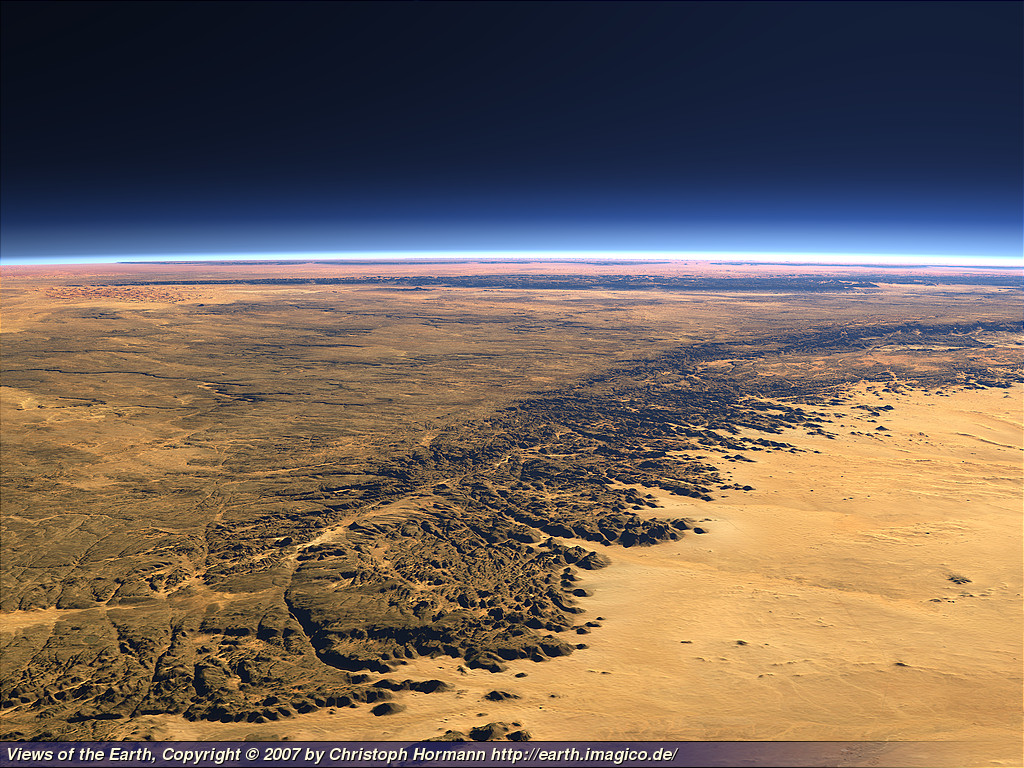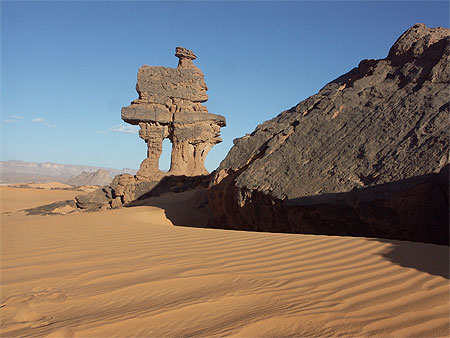Tassili N’Ajjer National Park is one of the most natural rock art museum in the world. This is the best place to observe and to see the most gorgeous and fantastics rock painting in the world. This place become so wonderful since there are so many people visiting this place and UNESCO as one of United Nations board which exclusively list all of the world most famous, most ancient, and most incredible “i dont know what to say, the point is amazing place in the world” as part of the world heritage include Tassili N’Ajjer National Park as one of their concern to be protected. The Tassili protected by UNESCO with refernce number 179.
 |
| Tassili from the top. |
UNESCO itself categorized Tassili N’Ajjer National Park as the wonderfull world heritage because it is completed 4 unique criteria that has been determining by UNESCO. The criterion are below :
Criterion (i): The impressive array of paintings and rock engravings of various periods gives world recognition to the property. The representations of the Round Heads Period evoke possible magic-religious practices some 10,000 years old, whereas the representations of the Cattle Period depicting daily and social life, and which are amongst the most famous prehistoric parietal art, have an aesthetic naturalistic realism.
Criterion (iii): The rock art images cover a period of about 10,000 years. With the archaeological remains, they testify in a particularly lively manner to climate changes, changes in fauna and flora, and particularly to possibilities provided for farming and pastoral life linked to impregnable defensive sites during certain prehistoric periods.
Criterion (vii): With the eroded sandstone forming "rock forests", the property is of remarkable scenic interest. The sandstone has kept intact the traces and marks of the major geological and climatic events. The corrosive effects of water, and then wind, have contributed to the formation of a particular morphology, that of a plateau carved by water and softened by the wind.
Criterion (viii): The geological conformation of Tassili n'Ajjer includes Precambrian crystalline elements and sedimentary sandstone successions of great paleo-geographical and paleo-ecological interest.
Tassili, a mountainous region covering an area of 72,000 sq. Km, it is located in the centre of the Sahara in Tamanrasset Province, situated to the south-east of the Algerian Sahara and bordered by the Libyan Arab Jamahiriya, Niger and Mali, is a strange lunar landscape of deep gorges, dry river beds and 'stone forests'. Located in a strange lunar landscape of great geological interest, this site has one of the most important groupings of prehistoric cave art in the world. More than 15,000 drawings and engravings record the climatic changes, the animal migrations and the evolution of human life on the edge of the Sahara from 6000 BC to the first centuries of the present era. The geological formations are of outstanding scenic interest, with eroded sandstones forming ‘forests of rock’.
 |
| Sahara Desert. |
During the prehistoric period Tassili benefited from climatic conditions which were more favourable to human occupation. The abundance of game, the possibilities of animal husbandry and of pastoral life which lay within immediate proximity of impregnable defensive sites constituted the basic factors which favoured population development.
 |
| What a beautifull rock formation. |
The unique rock formations and networks of steep-sided valleys of the plateau are a result of the alternation of wet and dry periods. At the end of the Upper Pleistocene, for example, there were huge lakes in the region, in what are today the great Ergs. The lakes were fed by rivers flowing down the Tassili, and dry river beds remain from this period. The action of the rivers on the surface of the plateau formed deep gorges and separate plateaux. Over the last 10,000 years the area has become steadily drier, although this process was reversed by a more humid period from 4000 BC to 2000 BC. Wind erosion during dryer periods has formed rock formations which resemble ruins, known as 'stone forests'.
The plants and animals found on the plateau bear witness to former wetter periods. Relict species surviving in wet microclimates include fish and shrimp and, until the 1940s, a dwarf Saharan crocodile, many thousands of kilometres from the nearest population in Egypt.
 |
| Animal in Tassili. |
From about 6000 BC to the early centuries of the Christian era, the various peoples who inhabited this plateau left numerous traces in the archaeological record: settlements, tumuli and enclosures that have yielded abundant ceramic material. However, Tassili owes its world renown to the paintings and the rock engravings of all kinds found since 1933. This art covers several periods, each of which corresponds to a particular fauna, yet each can equally be characterized by stylistic differences, without reference to an ecosystem.
Five different periods can be identified: the naturalistic period, in which the fauna of the savannah is depicted; the archaic period, when small schematic figures or colossal forms assume the aspects of pictograms charged with an evident magical significance; the Bovidian period (4000-1500 BC), the dominant period in terms of the number of paintings, during which the representation of bovine herds and the scenes of daily life, incorporating a renewed naturalistic aesthetic, are among the best known examples of prehistoric mural art; the Equidian period, covering the end of the Neolithic and protohistoric periods, which corresponds to the disappearance of numerous species from the effects of progressive desiccation and to the appearance of the horse; and the Cameline period, during the first centuries of the Christian era, coinciding with the onset of the hyper-arid desert climate and with the appearance of the dromedary. This site has one of the most important groups of prehistoric cave art in the world. The most important group of paintings is situated to the east of Djanet in the National Park; other remarkable works of rock art are located to the north, in the region of the Wadi Djerat near Illizi.
How To Get To Tassili Park
Once already have a plan or holiday travelling list, the most important things is to make ensure that arrive at the Tamanrasset first with safe( why i say saved because there are so many kidnapped accident since 2003 in Algeria). Tamanrasset is about 974 miles from Houari Boumediene Airport. To be there in Tamanrasset to visit Tassili park can be done by using airplane. All the flight will be arrived at Houari Boumediene Airport (Algiers, Algeria), Right now, 20 airlines operate out of Houari Boumediene Airport. Houari Boumediene Airport offers nonstop flights to 65 cities. Every week, at least 343 domestic flights and 504 international flights depart from Houari Boumediene Airport. There are to choices flight can be choosed that are Saudia and Air Algeria. Air Algerie operated a convenient direct flight from Paris to Djanet. Though there were persistent rumors that they will recommence, this was squashed with the kidnappings of foreign tourists in 2003. For the time being the only viable way is taking a connection via Algiers. Fortunately Air Algerie have rescheduled their domestic flights to Djanet and Tam to connect with the european arrivals and departures, so it's possible to avoid having to spend a night in Algiers both ways. The flights are pricey, a roundtrip from Europe will cost 600 - 750 Euros per person, more if one of the few European airlines are used to fly till Algiers (typically a domestic add on to an international ticket will be much cheaper than buying the two tickets separately.) With Air Algerie it is possible to obtain a ticket flying in to Djanet and returning from Tamanrasset, or vice versa for the same price.
There used to be occasional direct charters to Djanet from Paris, Munich, Zurich and Milan, however most of these stopped in 2003. As confidence (and security) slowly rebuilds, it may be worth while to ask around. These charters are usually taken up by groups organised by large tour operators, but frequently they have a few free places left which can be bought by independent travelers. The flight itself can be one of the highlights of the trip, especially at morning and late afternoon, when the low light contrasts the huge dune ranges of the Grand Erg Oriental. Arriving in Djanet is a wonderful experience, with the little airport composed of nothing but a runway in the sand and two low buildings. The luggage is offloaded from the airplane into the sand on the edge of the apron, to be packed on to the waiting camels and Landcruisers. A culture shock indeed...
If traveller will conduct as a bagpacker traveller, overland choice will be helpfull because with this mode trasportation there are so many things to do, there are so many things to see, and there are so many experience can be collected, especially if you love photography. This used to be the mode of choice for most independent travelers to the region, however due to the tigtened regulations following the 2003 kidnappings (mandatory guide, no off piste driving), this means have become quite a hassle. Obviously if the Tassili is included in a larger trip (including visits to the more remote outlying areas of the Tassili to the North & South of Djanet) this is the (only) practical way. However if the Tassili is the only main purpose, one needs to weigh the benefits and disadvantages: The trip via Tunisia is a long and mostly boring one, with really interesting landscape starting only when reaching the northern fringes of the Tassili. It is not possible to take a car up to the plateau itself, so it must be left behind in Djanet. Overall the cost in both direct expenditures and time may well be more than taking a flight. you will have longer time than use flight but may be the experince would not be the same as you take flight to go there.
 |
| Land Travel to the Tassili. |
As arrived at Tamanrasset. There is nothing to be worried about the accomodation. This place its not just a rural area. Some hotel can be booked to stay as long as holiday trip schedule. The hotel such as Complexe Touristique Saharien Bois Petrifie Tamanrasset hotel is ready to be lived temporary and there are still many hotels distribute all over Tamanrasset or Algeria.
Lets check the picture before arrive there.
 |
| Admire the rock painting. |
 |
| Rock formation with savana. |
| Foot track at the sand. |
| Fantastics rock painting. |
 |
| What a beautifull rock formation. |



 11:20 PM
11:20 PM
 Unknown
Unknown

 Posted in:
Posted in: 


0 comments:
Post a Comment